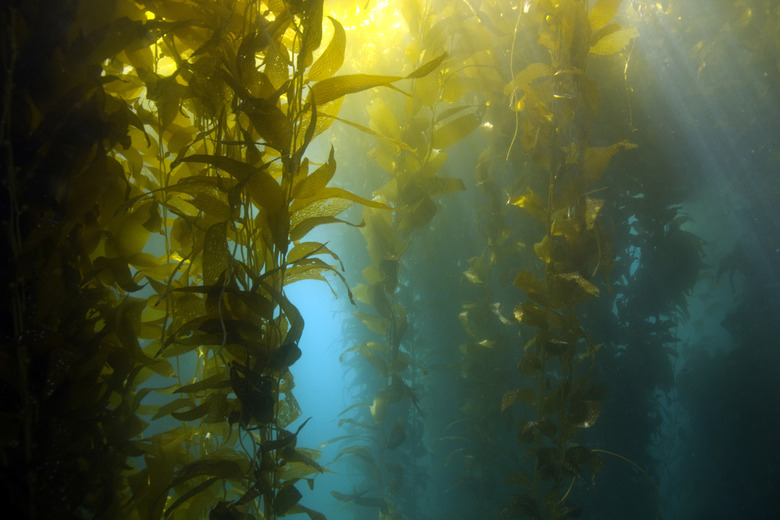Facts About Seaweed
What is seaweed, and is seaweed a plant? To be exact, seaweed is a type of multicellular algae, and true algae like seaweed belong to the kingdom Protista (not the kingdom Plantae). Algae are simple, plantlike organisms that are believed to be ancestors of modern-day land plants. Lacking vascular tissues like xylem and phloem, plantlike algae also do not have true roots, stems or leaves.
There are two types of algae: microalgae and macroalgae. Small microalgae are also known as phytoplankton, and large macroalgae are called seaweed. Like true plants, both phytoplankton and seaweed contain chlorophyll and are photosynthetic.
Structure of Seaweed
Structure of Seaweed
There are thousands of species of seaweed, including varieties that live in oceans, rivers and lakes. The microscopic varieties of algae called phytoplankton float around, suspended in the water where they live. Seaweed, on the other hand, attaches itself to the floor of the ocean or rocks along the shores of rivers and lakes.
Because seaweed does not have true roots, it attaches itself with structures called holdfasts, according to Britannica Kids. Unlike roots, holdfasts do not take in nutrients – they simply anchor the seaweed to a solid structure. Instead, seaweed absorbs nutrients through blades, which are leaf-like structures, notes The Marine Diaries.
Seaweed also does not grow stems like land plants. The blades of seaweed emerge from what is called a stipe, which is similar to a stem. A frond is a group of blades that extend from one stipe. Some seaweeds grow air bladders on their blades or stipes to help them float in the water, according to The Maine Seaweed Council.
Types of Seaweed
Types of Seaweed
Seaweed is divided into three main groups, by color: green, red and brown. Green seaweed is the least common. Sea lettuce (Ulva spp.) is one type of green seaweed that grows in the ocean, and its name comes from the fact that it is eaten by humans in salads and soups.
There are more than 4,000 species of red seaweeds, including Irish moss (Chondrus crispus) and some types that grow in coral reefs. Each type of seaweed has its own habitat, and many red seaweeds grow in places where they can attach themselves to other organisms.
Brown seaweeds grow in colder waters, and there are about 1,500 species in this group. Giant kelp is one type of brown seaweed. Often growing in towering groups, kelp form dense clusters in shallow waters, creating communities that are like underground forests. Giant kelp can grow over 33 meters long, and scientists have recorded ten to twelve inches of growth a day in giant kelp that live in Monterey Bay off the coast of California.
Importance of Seaweed
Importance of Seaweed
Besides being an important food source in parts of the world, seaweeds also contain anti-inflammatory, anti-microbial and cancer-fighting compounds that are used for medical purposes, according to the National Ocean Service. Seaweeds have been used for thousands of years for their health-promoting properties.
Seaweeds also play an important role in underwater ecosystems. They provide food and shelter for fish and other marine animals like sea urchins and crustaceans. Living at the base of the food chain, they support many other life forms in aquatic communities.
Just like other photosynthetic organisms, seaweeds produce oxygen as a byproduct of photosynthesis. It is estimated that algae produces 30 to 50 percent of Earth's oxygen, which sustains humans and other species that live on land and in the sea. As it captures carbon, seaweed also helps to reduce the acidity of the ocean.
Seaweeds reduce pollution by absorbing excess nutrients and toxins – like organic chemicals and heavy metals – from the water. They also soak up micronutrients and antioxidants from clean water, making them an excellent fertilizer for farms. Seaweeds are used in human foods, medicines and cosmetics, as well as in animal feeds.
Cite This Article
MLA
Sloane, Christina. "Facts About Seaweed" sciencing.com, https://www.sciencing.com/seaweed-5422393/. 30 September 2021.
APA
Sloane, Christina. (2021, September 30). Facts About Seaweed. sciencing.com. Retrieved from https://www.sciencing.com/seaweed-5422393/
Chicago
Sloane, Christina. Facts About Seaweed last modified March 24, 2022. https://www.sciencing.com/seaweed-5422393/
